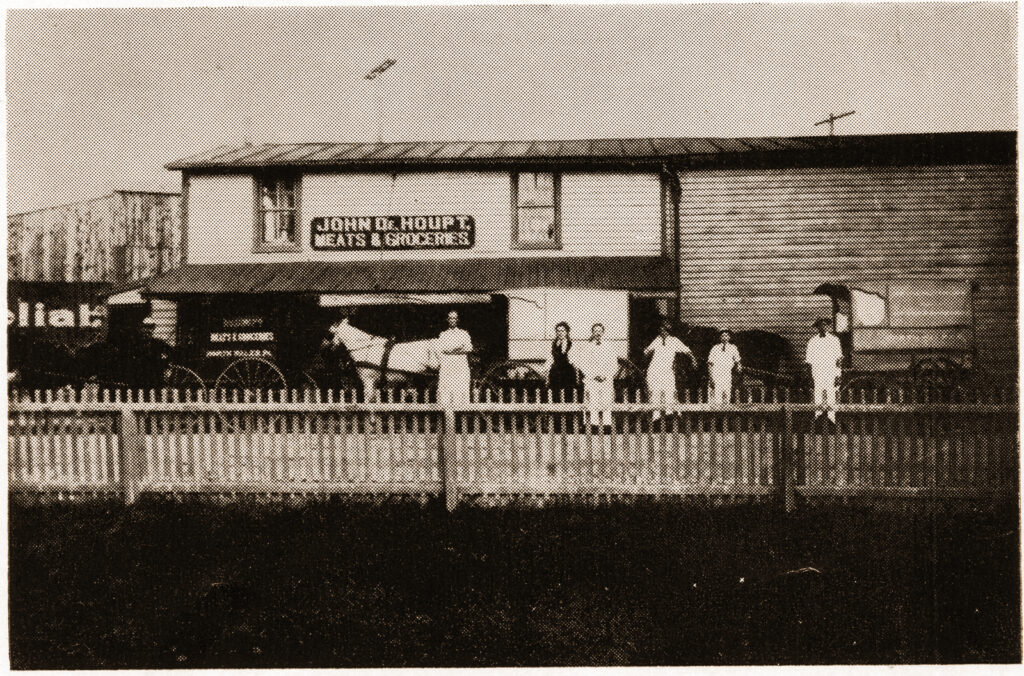On October 22, 1869, North Wales Borough Council finally started to function and its first official act was the passing of an ordinance compelling property owners on Main Street to lay sidewalks six feet wide with a pavement of brick, stone or wood. These sidewalks were to be completed within thirty days.

At the next meeting of council, October 27, 1869, the meeting place was changed from Lukens’ Hall to the office of Messrs. Moyer and Shearer. This office was on the site of the one now [1959] occupied by A. K. Shearer on Second street. At this meeting council passed an ordinance requiring pavements to be laid on Montgomery Avenue and Third street and that Montgomery Avenue was to be opened from Third to Second streets.
The meeting place was again changed on November 3, 1869, from the office of Moyer and Shearer to the borough clerk’s office. Mr. Wampole, the clerk, was also a justice of the peace and had his office at 107 North Second street. At this meeting it was resolved that the street commissioner receive a salary of two dollars per day for every day necessarily spent in the performance of his duties.
In order that the actions of council be legally correct it has always been necessary to employ a solicitor, and accordingly, on November 17, 1869, Henry F. Moyer appointed a committee to employ a solicitor for the town council at a salary not exceeding twenty-five dollars per year for his services. At the next meeting, November 24, 1869, Mr. Moyer reported that he had engaged the services of George N. Corson for a term ending January 1, 1871, at a salary of twenty-five dollars per year.
Apparently parking was a problem in 1869, as it is now, for at the meeting of council held on December 8, 1869, a petition was presented by citizens of the borough requesting an ordinance to prohibit any cart, stage, wagon, carriage or vehicle of any kind from remaining on any pavement, footway, or public crossing longer than a certain fixed time, under a penalty of (blank) dollars, to be recovered before the burgess or a justice of the peace; one-half of the fine to be paid to the informer. Also an ordinance making it a penalty for any person or persons to lead or drive a horse or any other animal along and on any footway or pavement. These petitions were received for consideration and future action.
On December 15, 1869, the matter was again brought up, but on motion laid on the table. A search of the records fails to disclose any further action.

The meeting of December 29, 1869, proved to be an important one in that by-laws and rules were adopted for the government of council. These by-laws and rules are lengthy and have long since been made obsolete by the Legislature of Pennsylvania which created the borough code, and under which all boroughs must function.
The next important matter brought to the attention of council at this meeting was, “The question of lodging strangers or vagrants coming into the borough, which was introduced by Mr. Anders, and after discussing the subject it was on motion, resolved that the clerk obtain the solicitor’s opinion and advice as to the duty of, and the proper course for, the council to pursue in cases where the hotel keepers of the borough of North Wales refuse to entertain and lodge such strangers upon application.”
On January 12, 1870, the matter of lodging strangers again occupied the attention of council when, “A petition was presented asking for the erection of a lock-up or station-house, the propriety of which was discussed, and on motion of Mr. Freed the subject was referred to Messers. Cathrall and Anders with instructions to report at the next meeting of council.”
At this meeting there was another petition presented asking for the erection of twelve street lamps and the appointment of a lamp lighter. This petition was referred back for more signers.
We quote in full the next meeting of council which reads as follows:
“At a special session of the council convened on Thursday evening, January 20, 1870. for the purpose of taking into consideration the propriety of erecting a suitable building for a lock-up house and a site upon which to erect the same. When Joseph K. Anders on behalf of the committee appointed at a former meeting of the council, made report, from the opinion received from George N. Corson, the council solicitor, it appears to be the duty of the council to erect such a building within the borough, and that a lot of ground upon which to erect the same fronting on Third street, bounded by lands of Frederick Mull and Daniel Kenderdine can be purchased for about fifty-four dollars. [Today this is the side yard of the house across the street from the beer distributor.] Whereupon on motion of E. K. Freed it was resolved that the town council erect within the limits of the borough a building suitable for a lock-up or station house, and that a committee be appointed to purchase a suitable lot of ground upon which to erect the same. The president appointed E. K. Freed and Joseph K. Anders to said committee.”
We will continue this article in subsequent blog posts.
This post is sourced from a column entitled Early North Wales: Its History and Its People penned by long-time North Wales resident historian Leon T. Lewis. The article appeared in its original form in the August 18, 1959 issue of the North Penn Reporter.
